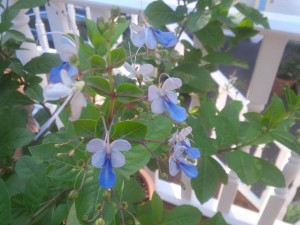
I admit to a love/hate relationship with houseplants and I don’t need a psychologist to explain it. My deep-seated ambivalence stems from the fact that most of my houseplants are tropicals or tender plants that only cohabit with me during the cold weather months. When night temperatures are above 50 degrees Fahrenheit, they lounge on the porch or fill “holes” in the beds and borders. When the weather is sunny, they bloom like crazy and produce an abundance of shoots and leaves.
And then they come inside.
Like humans, most plants tend to slow down or even go completely dormant in winter. Generally, indoor gardeners cut out routine feedings and limit watering during this time. Depending on the species and variety, the plants may lose leaves or just sit there looking forlorn. For those of us who like signs of growth, fresh green leaves and, above all, flowers, the whole winter thing can be depressing.
This is why I always think twice about investing in tropicals. My daughter, however, is not bound by those scruples. This is probably because she is only a sporadic tender of houseplants and never feels guilty about it. I on the other hand, see chlorosis, or yellowing leaves, and start feeling guilty immediately. Maybe it is the maternal instinct at work.
My daughter is responsible for bringing blue glorybower, sometimes known as blue butterfly bush, into my life. She saw it across a crowded room at a local nursery and immediately heard music, glimpsed a flutter of angels overhead and nearly swooned over its beauty. She has not been this smitten this quickly since the first episode of the TV series Outlander.
The object of this love-at-first-sight experience was a shrubby plant, about three feet tall, including its container. Its sturdy stems were adorned with opposed pairs of elliptical green leaves and covered with clusters of blue, butterfly-like flowers. In fact, the shrub in full bloom looked like a large flock of small butterflies about to take off. It was gorgeous.
A closer inspection revealed that the “butterflies” were actually five-petaled flowers, each about one inch wide. The four main “wings” were petals of palest blue that contrasted with a fifth, elongated petal in a darker shade that had just a hint of purple. Long, prominent, curving stamens added to the sense of movement.
All my reservations about overwintering tropical plants flew out the window. We grabbed the blue glorybower–formerly known as Clerodendron ugandense, and now going by the long, Latin moniker, Rotheca myricoides ‘Ugandense’—and moved on in search of other ways to max out our garden spending allowance.
Clerodendron, former generic home of blue glorybower, is a large—around 400 species—group of shrubs and trees, mostly native to the tropics. The species within it, including blue glorybower, used to be classified as part of the Verbena family, but have now moved on to the enormous mint or Lamiaceae clan. The association makes sense when you look at the stems, which are square in cross section; and the evergreen leaves, which are paired on the stems and exude a pungent aroma when rubbed or crushed. Some of its relatives are popular ornamentals, including the red-and-white-flowered glorybower, or bleeding heart vine, and the orange-red-flowered flaming glorybower vine.
In keeping with its Latin species/varietal name, “ugandense”, the blue glorybower is native to Uganda and Kenya in East Africa. Left to its own devices and grown outdoors year-round, it might reach ten feet or more in height. Fortunately, it blooms on new wood, so it can be pruned to keep it to a reasonable size. Like most flowering plants, it appreciates receiving those haircuts right after the petals fall.
Our new blue glorybower is luxuriating on the sunny back porch, after a spell in the lower back garden during our recent house painting adventure. Since we acquired it over the Memorial Day weekend, it has had three distinct flushes of bloom, each larger than the last. The blooms are succeeded by small, green, berry-like fruits, but I clip those off as part of the pruning ritual. The flowers are not fragrant, but it really does not matter because they are so beautiful. When the petals are spent, they drop off cleanly, leaving a scattering of blue confetti on the porch planks.
The garden information sources tell me that I can expect my glorybower to have the usual less-than-glorious spell after it comes inside for the winter. However, anything that blooms in profusion three times in nine weeks will have earned its rest by October or so. I will try to remember that when the plants and I are all suffering from Seasonal Affective Disorder in January.
Local nurseries and garden centers sometimes carry blue glorybower, but you can also get a small—4-inch—starter pot on Amazon. Rest assured that it will grow fast—except possibly in winter.

